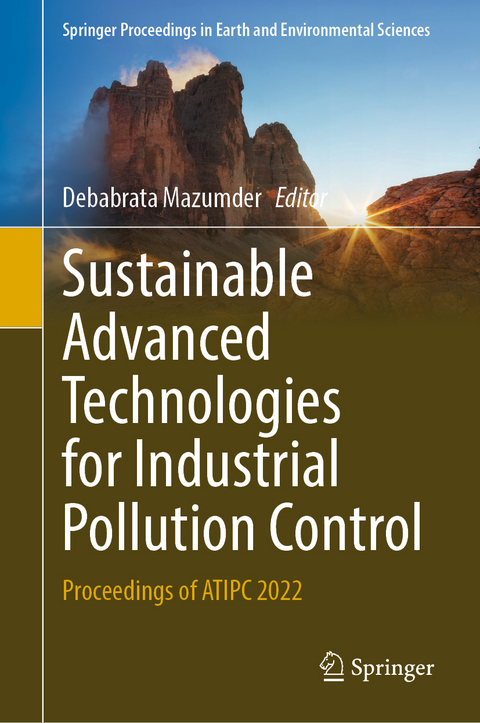
Sustainable Advanced Technologies for Industrial Pollution Control
Springer International Publishing (Verlag)
978-3-031-37595-8 (ISBN)
This proceedings volume constitutes peer-reviewed full-length papers contributed by the Authors and tailored on various thematic areas of the 3rd International Conference on "Advanced Technologies for Industrial Pollution Control" (ATIPC - 2022). The areas of research covered by these papers include but are not limited to:
-Water quality monitoring and treatment in industrial area
-Industrial effluent treatment, reuse and conservation
-Monitoring of industrial emission and control
-Industrial solid waste management-Handling and disposal of hazardous waste
-Case Studies on industrial pollution control
-Innovative technologies in industrial waste management
lt;p>Dr. Debabrata Mazumder is a Professor in the Department of Civil Engineering at the Indian Institute of Engineering Science and Technology, Shibpur.
Chapter 1: Water decontamination through Thiamethoxam removal using DL menthol-octanoic acid Deep Eutectic Solvent : Molecular dynamics insights.- Chapter 2: Methyl Red dye abatement from aqueous solution using Calcium Ferrite and Manganese Ferrite magnetic nanocomposite: Kinetics and isotherm study.- Chapter 3: Adsorption of Fluoride onto PANI-Cl jute fibre - designing higher flow rate and initial concentration column reactor from a batch reactor.- Chapter 4: Biosynthesis of Nano Zero valent Iron (nZVI) using Shorea robusta Leaf Extract and its application in UV-assisted Photocatalytic Degradation of Methyl Orange.- Chapter 5: Method Development for detection of 2-Methylpyridine by High Performance Liquid Chromatography.- Part 2 - Industrial effluent treatment, reuse and conservation.- Chapter 6: Importance of cost functions for biological treatment of wastewater.- Chapter 7: Removal of heavy metals by Laterite soil.- Chapter 8: Removal of Methylene Blue from wastewater by Red Sandy soil-Based Alkali activated binder.- Chapter 9: Assessment and Treatment of iron from industrial wastewater using activated carbon derived from Parkia Speciosa pod.- Chapter 10: Activated Carbon developed from Phumdi biomass and Deccan Hemp for adsorption of Methylene Blue.- Chapter 11: An experimental study of Metanil Yellow dye remediation using Fe-Mn Bimetal oxide composites.- Chapter 12: Optimization of electrocoagulation process parameters using magnesium electrodes for treating pharmaceutical wastewater containing salicylic acid.- Chapter 13: Optimization of process parameters for biodegradation of Cresol by mixed bacterial culture using Response Surface Methodology.- Chapter 14: Biological degradation of Cresol containing wastewater using mixed microbial culture in presence of heavy metals.- Part 3 - Monitoring of industrial emission and control.- Chapter 15: Development of a simplistic model for the prediction of reactive air pollutants in the atmosphere.- Chapter 16: Controlling Air and Metal pollution in industrial area Singrauli, India: Role of plants.- Part 4 - Industrial solid waste management.- Chapter 17: Enhancing the dewatering ability of sludge by locally available biomass.- Chapter 18: Production of Xylose from Water Hyacinth Biomass (WHB) (lignocellulosic waste) for Xylitol production: waste to wealth.- Chapter 19: A simplistic mathematical model for two-stage Anaerobic Digestion of plastic wastes.- Part 5 - Handling and disposal of hazardous waste.- Chapter 20: Modeling migration of Cr(VI) contaminant through Clay Liner using Hydrus-3d.- Chapter 21: Electrokinetic remediation of total Chromium from contaminated soil.- Chapter 22: Low-Cost recovery of Cadmium from wastewater by soil bacteria.- Part 6 - Case Studies on industrial pollution control.- Chapter 23: Tannery waste management in India: A case study.- Chapter 24: Removal of natural organics and selected antibiotics using PAC and AL electrode: A study for Jumar River.- Chapter 25:Quantification of floating plastics using UAV images and Identification of Microplastics in Ukkadam tank.- Chapter 26: Study of wastewater treatment in Hindustan Coca-Cola plant at Khurda.- Part 7 - Innovative technologies in industrial waste management.- Chapter 27: In Vitro Performance Analysis of Ti and Zn doped Hydroxyapatite made from waste Eggshells.- Chapter 28: Production of non-toxic, non-polluting herbal soaps using plant extracts having anti-microbial activity.- Chapter 29: Decolourization of Textile Dye RR 141 using electrochemical process.
| Erscheinungsdatum | 22.09.2023 |
|---|---|
| Reihe/Serie | Springer Proceedings in Earth and Environmental Sciences |
| Zusatzinfo | XVI, 408 p. 232 illus., 175 illus. in color. |
| Verlagsort | Cham |
| Sprache | englisch |
| Maße | 155 x 235 mm |
| Gewicht | 792 g |
| Themenwelt | Sachbuch/Ratgeber ► Natur / Technik ► Natur / Ökologie |
| Naturwissenschaften ► Biologie ► Ökologie / Naturschutz | |
| Naturwissenschaften ► Geowissenschaften | |
| Schlagworte | Advanced Technologies • Industrial pollution control • Noise Pollution • Radioactive Waste Management • Solid hazardous waste • sustainability • Water pollution |
| ISBN-10 | 3-031-37595-5 / 3031375955 |
| ISBN-13 | 978-3-031-37595-8 / 9783031375958 |
| Zustand | Neuware |
| Haben Sie eine Frage zum Produkt? |
aus dem Bereich


